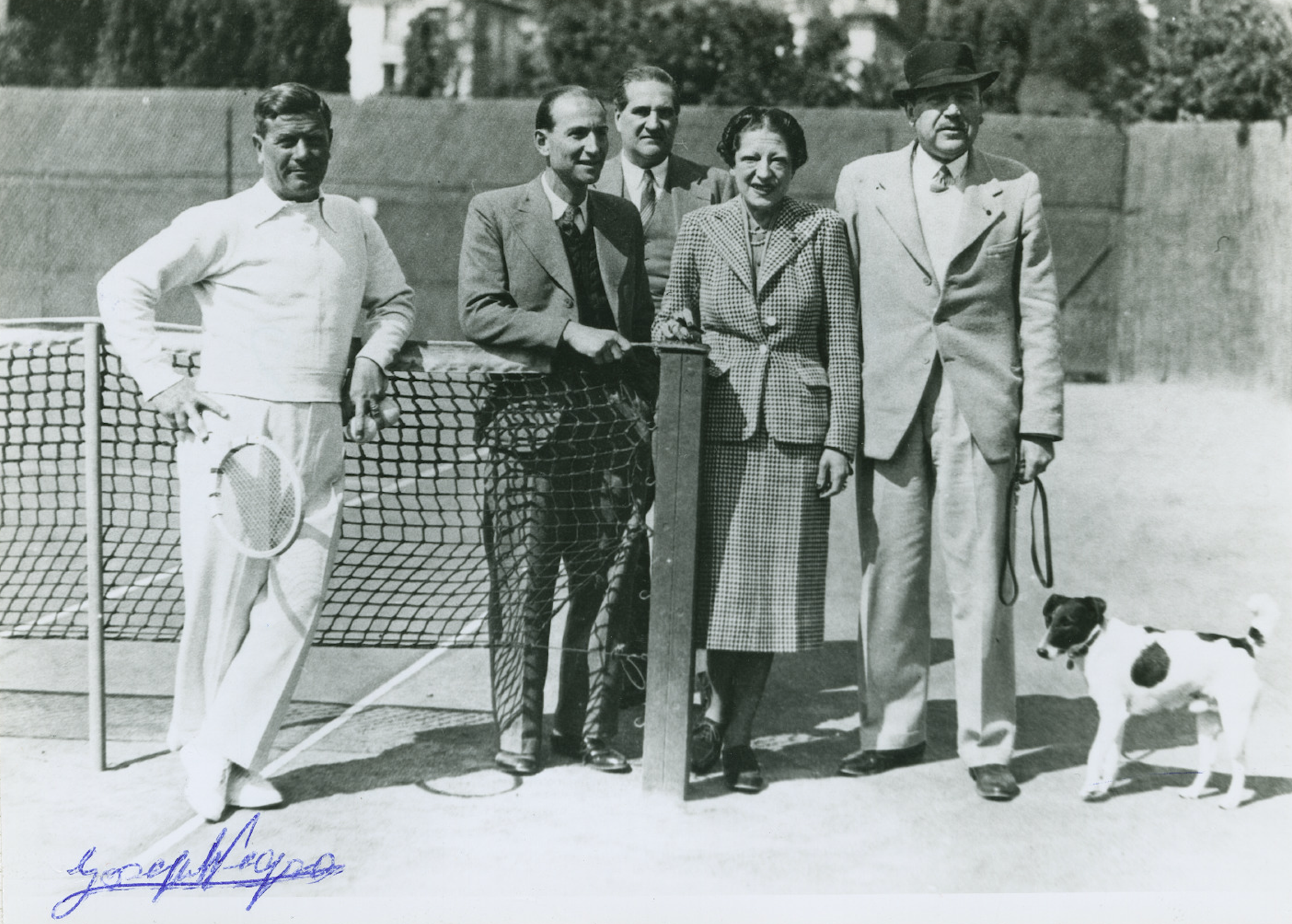
Joseph Negro (far left), René Tissot, Emmanuel Defforges, Suzanne Lenglen, Negro’s former student and among the greatest champions in tennis history, and Pierre Gillou, President of the French Tennis Federation (1930-40) and of the International Tennis Federation (1938-47). Nice, France. April 1938. Courtesy of Gérald De Feo.
In my earlier note (The Nabokovian 67 [Fall 2011]: 7–13), I explored tennis references in The Original of Laura. Nabokov’s unfinished last novel, inter alia, contains a passage that describes Flora, while in Cannes, “taking her tennis lessons with the stodgy old Basque in uncreased white trousers who had coached players in Odessa before World War One and still retained his effortless exquisite style” (TOOL 81).
As I previously pointed out, Flora’s tennis coach has some real prototypes, of whom
Joseph Negro is the most obvious. In his letter to Roman Grinberg of February 23, 1961, from Nice Nabokov writes, “I play here with a professional [named] Negro who once coached in Russian tennis clubs, for example, in Odessa before World War One! A wonderful semi-lame swarthy old man who comes to life on court like cactus breaking into blossom” (“Igraiu tut s professionalom Negro, kotoryi kogda-to uchil v russkikh tennisnykh klubakh, napr<imer> v Odesse do pervoi voiny! Chudnyi polukhromoi smuglyi starik, kotoryi ozhivaet na ploshchadke, kak zatsvetshii kaktus”); see Rashit Iangirov, publ., “Druz´ia, babochki i monstry. Iz perepiski Vladimira i Very Nabokovykh s Romanom Grinbergom [1943–1967],” Diaspora 1 (2001): 534). As can be seen, some fifteen years after the encounter, Nabokov recalled this very specific detail—Joseph Negro’s teaching tennis in Odessa before World War One—and bestowed it on his fictional character. One wonders whether Nabokov knew this, but according to Gérald De Feo, his grandfather gave tennis lessons to members of the Russian imperial family. For this service, Joseph Negro received a pair of gold cufflinks encrusted with sapphires.
Since the note publication seven years ago, new information about Joseph Negro came to light, which I would like to share here, and in so doing, to correct some earlier factual inaccuracies.
Joseph Negro was born on December 17, 1896, in Nice, France. In the 1880s, his family had moved there from Niella Tanaro, a small municipality in Cuneo Province, located about 70 km south of Turin, in the Italian region of Piedmont. The Negro family relocated from Northern Italy, where it owned and ran a bakery, to the French Riviera because of a famine caused by the wheat blight disease.
Joseph Negro became attracted to tennis from a very early age. He first worked as a ball boy and later began playing tennis and giving tennis lessons. With the outbreak of World War One, he was drafted into the French army and was sent to the Italian front. During his military service, Joseph Negro sustained a leg injury that resulted in a permanent limp. Nevertheless, in spite of this disability, he succeeded in becoming a three-time finalist (1920, 1922, and 1923) of the Bristol Cup, also known as the French Pro, the most prestigious professional tournament of the time <http://en.wikipedia.org/wiki/French_Pro_Championship>.
Coach Negro’s lifelong student was the illustrious Suzanne Lenglen (1899–1938), a six-time French Open and a six-time Wimbledon women’s singles champion. Since the late 1930s and until his passing, Negro had served as a Professor of A. F. P. P. T.—the French Association of Tennis Professors and Professionals—alongside such greats as Romeo Acquarone, Henri Cochet, Henri Darsonval, and Martin Plaa (see Philippe Brossard, Prof ou champion de tennis: tennis-études et sélections pour futurs champions. Comment devenir prof de tennis, Paris: Editions EDICIS, 1991, between 112 and 113). Negro coached the national teams of Italy and Ireland. He also gave tennis lessons to many famous personalities, such as Alain Gerbault, a French navigator and writer; Gustaf V, King of Sweden; Charlie Chaplin, and Vladimir Nabokov. Apparently, Negro looked older than his age if Nabokov called him an “old man,” even though he was less than two and a half years Nabokov’s senior.
On May 20, 1930, Joseph Negro married Maria (née Pellegrino) who hailed from Centallo, located not far from his ancestral home in the Piedmont region. They had one child, a daughter, Mireille (1934–2013). Joseph Negro taught tennis at the Nice Lawn Tennis Club until his very last day. He died on April 23, 1971.
I am greatly indebted to Gérald De Feo, Joseph Negro’s grandson, for providing this invaluable new information.
—Gavriel Shapiro, Ithaca, New York
